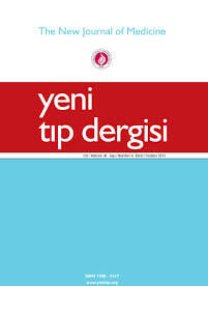Nikotin bağımlılığının sigara bırakmadaki etkisi
Sigara içme, Tütün kullanım bozukluğu, Sigarayı bırakma
The effect of nicotine dependence on smoking cessation
Smoking, Tobacco Use Disorder, Smoking Cessation,
___
- 1. WHO Report on the Global Tobacco Epidemic, 2009: Implementing smoke-free environments. Available from: URL: http://www.who.int/ tobacco/mpower/en/.
- 2. Kara S, Yılmaz U, Polat G, et al. Smoking habits in lung cancer patients: a hospital based case-control study in İzmir, Turkey. Turkish Respiratory Journal 2004;5:102-9.
- 3. WHO report on the global tobacco epidemic, 2008: The MPOWER package. Available from: URL: http://www.who.int/tobacco/mpower/2008/ en/index.html.
- 4. WHO Programme on Tobacco and Health. Report of the Director – General to the Executive Board. Geneva: WHO, 1985.
- 5. Hughes JR. Smoking and suicide: A brief overview: Drug and Alcohol Dependence 2008;98:169–78.
- 6. Koszowski B, Goniewicz M, Czogała J. Alternative methods of nicotine dependence treatment. Przegl Lek 2005;62(10):1176-9.
- 7. Galle, M. Biophotonen ud MORA- Bioresonanz–eine theoretische Annäherung. Erfahrungsheilkunde 2005;54:293-300.
- 8. Schumacher P: Biophysikalische Therapie der Allergien. pp 125- 133, 147-154, Stuttgart, Sonntag 1998.
- 9. Nardini S. The smoking cessation clinic. Monaldi Arch Chest Dis 2000;55:495-501.
- 10. Coşkun F, Karadağ M, Ursavaş A, Ege E. Öğretmenlerin Sigara İçme Alışkanlıkları ve Yeni Yasaya Bakışları: Solunum 2010;12(3):119–24.
- 11. Gratziou C, Tonnesen P. Smoking cessation and prevention. Eur Respir Mon 2006;38:242-57.
- 12. Anderson JE, Jorenby DE, Scott WJ, Fiore MC. Treating Tobacco Use and Dependence: An Evidence-Based Clinical Practice Guideline for Tobacco Cessation. Chest 2002;121:932-41.
- 13. Silagy C, Stead LF. Physician advice for smoking cessation. Chocrane Database Sys Rew 2001. CD000165.
- 14. Koszowski B, Goniewicz M, Czogała J. Alternative methods of nicotine dependence treatment. Przegl Lek 2005;62(10):1176-9.
- 15. Fiore MC, Jaen CR, Bailey WC, Bailey WC, Benowitz NL, Curry SJ, et al. Treating tobacco use and dependence: 2008 update U.S. Public Health Service Clinical Practice Guideline executive summary. Respir Care 2008; 53:1217-22.
- 16. Nides M. Update on pharmacologic options for smoking cessation treatment. Am J Med. 2008;121(4 Suppl 1):S20-31
- ISSN: 1300-2317
- Yayın Aralığı: 4
- Başlangıç: 2018
- Yayıncı: -
Hakan KILINÇ, HÜSEYİN CENGİZ, Cihan KAYA, Murat EKİN, LEVENT YAŞAR
Üremik koagülopatiye bağlı spontan dalak rüptürü
Akın ÖNDER, Ömer BAŞOL, Murat KAPAN, Güven TEKBAŞ, Sadullah GİRDİN
Yenidoğanın emme güçlüğü ve nonketotik hiperglisinemi
Tülin ÇATAKLI, Ülkü TIRAŞ, Önder CAN, Yıldız DALLAR
Dev kolon polibine bağlı kolokolik invajinasyon ve obstrüksiyon: Bir olgu
Alaattin ÖZTÜRK, Hikmet AKYÜZ, Ömer Faruk AKINCI
Can pregabaline be an alternative treatment for vulvodynia?
İkbal KAYGUSUZ, İlknur İNEGÖL GÜMÜŞ, Özlem ONUR, HİLAL USLU YUVACI, Evren SARIFAKIOĞLU
Callus like foreign-body reaction to hair: A puncture wound of the foot
Nikotin bağımlılığının sigara bırakmadaki etkisi
Mehmet KARADAĞ, Sema KARADAĞ, Bülent EDİZ, Ersal Salih IŞIK
Podositler ve nefrotik sendrom için yeni tedavi hedefleri
Nazım DENİZLİ, Yasemin KIRAÇ, Murat GÜCÜN, Recep DEMİRCİ, Murat DURANAY
Bacteriologic analysis of bile in cholecystectomy patients
Alaattin ÖZTÜRK, Hakan BOZKURTOĞLU, Cengiz KAYA, Necati TAN, Hülya ÇAŞKURLU, Ömer Faruk AKINCI
Ovarian fibromatosis mimicking malignant ovarian tumor: Case report
